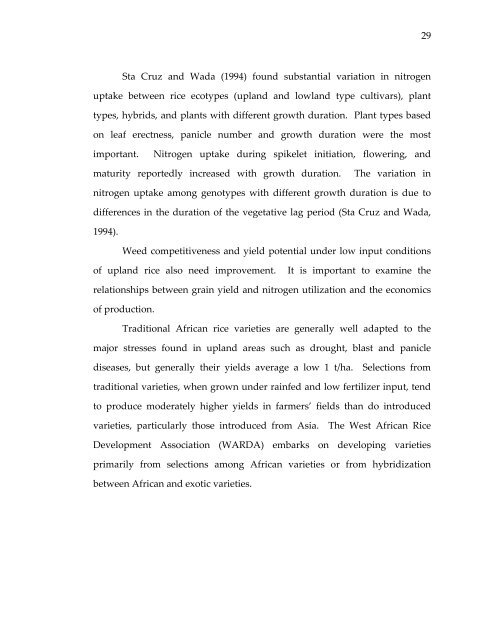Management of rice production systems to increase productivity
Management of rice production systems to increase productivity
Management of rice production systems to increase productivity
Create successful ePaper yourself
Turn your PDF publications into a flip-book with our unique Google optimized e-Paper software.
Sta Cruz and Wada (1994) found substantial variation in nitrogen<br />
uptake between <strong>rice</strong> ecotypes (upland and lowland type cultivars), plant<br />
types, hybrids, and plants with different growth duration. Plant types based<br />
on leaf erectness, panicle number and growth duration were the most<br />
important. Nitrogen uptake during spikelet initiation, flowering, and<br />
maturity reportedly <strong>increase</strong>d with growth duration. The variation in<br />
nitrogen uptake among genotypes with different growth duration is due <strong>to</strong><br />
differences in the duration <strong>of</strong> the vegetative lag period (Sta Cruz and Wada,<br />
1994).<br />
Weed competitiveness and yield potential under low input conditions<br />
<strong>of</strong> upland <strong>rice</strong> also need improvement. It is important <strong>to</strong> examine the<br />
relationships between grain yield and nitrogen utilization and the economics<br />
<strong>of</strong> <strong>production</strong>.<br />
Traditional African <strong>rice</strong> varieties are generally well adapted <strong>to</strong> the<br />
major stresses found in upland areas such as drought, blast and panicle<br />
diseases, but generally their yields average a low 1 t/ha. Selections from<br />
traditional varieties, when grown under rainfed and low fertilizer input, tend<br />
<strong>to</strong> produce moderately higher yields in farmers’ fields than do introduced<br />
varieties, particularly those introduced from Asia. The West African Rice<br />
Development Association (WARDA) embarks on developing varieties<br />
primarily from selections among African varieties or from hybridization<br />
between African and exotic varieties.<br />
29
















